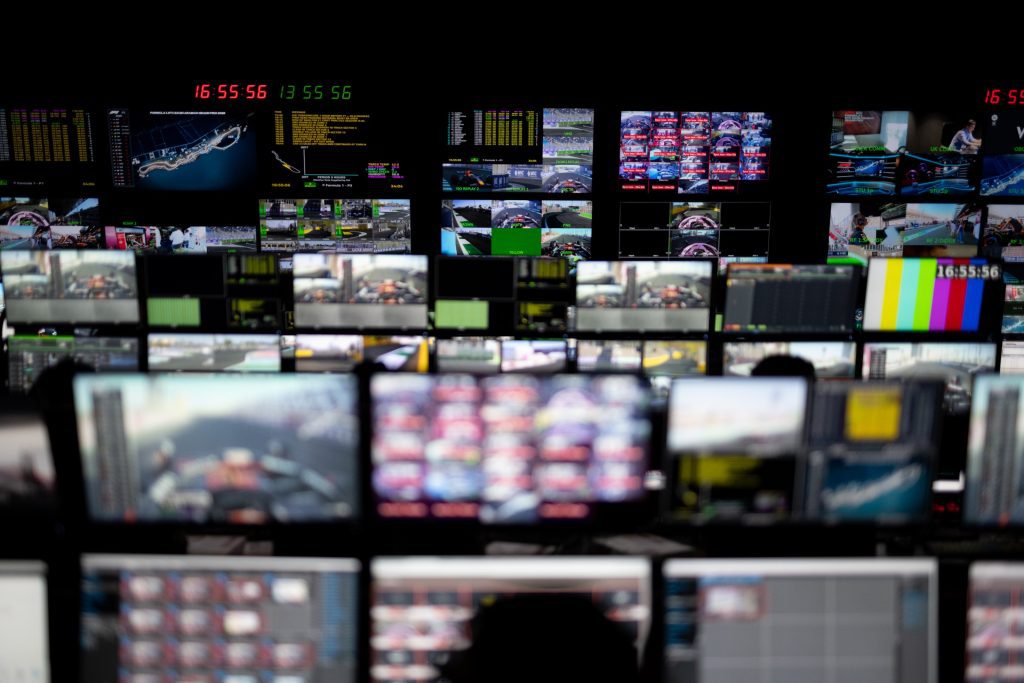Hitting sustainability goals is a challenge for any organization. When your business is the world’s most popular motorsport, which throughout the year races 20 insanely quick cars around 24 circuits as far afield as Azerbaijan and Australia, that challenge is immeasurably harder.
So for Formula 1®, it was a huge step forward when they decided to centralize all media operations in one place: Biggin Hill. It was a huge undertaking, demanding technology of the highest caliber, driven by a team of peerless professionals.
Up until four years ago, that broadcast operation criss-crossed the globe from race to race, clocking up countless miles in the process.
Today, however, the entire show is produced from an unassuming building nestled on an industrial estate in South East London. This is F1’s Media and Technology Centre (M&TC) – and it has to be seen to be believed.

Mission Control
“This building is our mission control,” says Pete Samara, F1 Director of Strategic Technical Ventures, as he surveys the massed ranks of over 400 monitors which transmit race images in real time. “Formula 1 is always on the edge of innovation. With the cars, with our fans, with our products, with the data, with the video, with the audio. Broadcast is key to what we do.”
Where previously 250+ staff would travel the world to make this happen, that number has been reduced to around 130. Likewise, the weight of the travelling technology has been reduced by 100 tonnes thanks to Biggin Hill’s data processing capability.
Packaging and distributing the footage for TV broadcasters in 180 territories around the globe requires world class and fail-safe technology. And the transmission gear which travels to the races, must withstand the relentless conditions inherent to elite level racing.
“Formula 1 is the most data-rich sport anywhere on the planet,” adds Chris Roberts, the organization’s IT Director. “We’ve got to make a million and one moving pieces synchronize and all come together in perfect harmony, and Lenovo helps bring that together for us.”

Attention to detail
The scale of the Biggin Hill operation is immense. Stepping into the M&TC, you immediately pass the team radio room. On race weekends, this hive of activity is overseen by Seb, a 21-year-old tech wizard who has honed the ability to monitor all 20 driver conversations – including highly competitive and emotional characters such as Max Verstappen and Lewis Hamilton – at once.
“There are eight of us in here, and we monitor all 20 feeds from the different cars,” he says. “To the untrained ear it can sound overwhelming, but we’ve trained ourselves to separate things out.
“The technology helps us by transcribing the words – and AI will soon make that even better – but you have to work fast. Thankfully we operate with a five second delay, which means we can turn down the volume if one of the drivers gets carried away in the heat of the moment.”
While this kind of deliberate delay has its uses, that is the opposite of what the M&TC seeks to achieve the rest of the time. Indeed, the timing loops at Biggin Hill are accurate to 1/1000th of a second.
In the Racing Systems Area, another team of technicians monitors all data coming from the track: speed, revs, gears, steering angle, pressure on the accelerator – even the G-force on a driver zooming around a corner are processed and fed through to the graphics team.
In the Broadcast Engineering studio, a team of experts remotely adjusts the exposure on every track camera to ensure that the Ferrari cars are seen in precisely the correct shade of red.
And it is not only the cars which push the limits of speed. All 500 terabytes of data across the race weekend are transmitted from the Event Technical Centre on track to the M&TC with a delay of just 180-250 milliseconds, regardless of race location.
One-stop-shop
Passing by the TV studio, you arrive at the broadcast nerve center: the Media Control Room. This is where dozens of producers put together the live feed for a global audience of 1.5 billion viewers every season.
High on the control room wall sit two digital clocks: one showing the time at the race location and the other for Biggin Hill. It serves as a constant reminder of the extraordinary technology required to make this kind of remote operation a reality.
In the depths of the building sits the data center, where Lenovo servers support F1 operations, allowing them to consolidate and reduce physical hardware due to its increased performance and processing capabilities. Data collection is a key element of F1’s sustainability journey, in close consultation with Lenovo’s specialists.
Having high quality service support is just as important as the technology. And once the tech has reached the end of its useful life, F1 uses Lenovo’s Asset Recovery Services to ensure the devices are recycled in a secure and environmentally conscious way.
“Lenovo’s very much a one-stop-shop for us, which is fantastic,” concludes Chris Roberts. “We not only get amazing technology but also access to some of the best techies and expertise to help us build solutions.
“F1 and Lenovo share a quest for perfection. They help us understand what the art of the possible is. And together we build that.”
